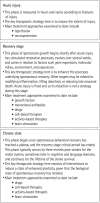Treatments to Promote Neural Repair after Stroke
- PMID: 29402069
- PMCID: PMC5836581
- DOI: 10.5853/jos.2017.02796
Treatments to Promote Neural Repair after Stroke
Abstract
Stroke remains a major cause of human disability worldwide. In parallel with advances in acute stroke interventions, new therapies are under development that target restorative processes. Such therapies have a treatment time window measured in days, weeks, or longer and so have the advantage that they may be accessible by a majority of patients. Several categories of restorative therapy have been studied and are reviewed herein, including drugs, growth factors, monoclonal antibodies, activity-related therapies including telerehabilitation, and a host of devices such as those related to brain stimulation or robotics. Many patients with stroke do not receive acute stroke therapies or receive them and do not derive benefit, often surviving for years thereafter. Therapies based on neural repair hold the promise of providing additional treatment options to a majority of patients with stroke.
Keywords: Neuronal plasticity; Recovery of function; Stroke; Stroke rehabilitation; Telerehabilitation.
Figures
References
-
- Johnston SC, Hauser SL. Neurological disease on the global agenda. Ann Neurol. 2008;64:A11–A12. - PubMed
-
- Writing Group Members. Mozaffarian D, Benjamin EJ, Go AS, Arnett DK, Blaha MJ, et al. Heart disease and stroke statistics-2016 update: a report from the American Heart Association. Circulation. 2016;133:e38–e360. - PubMed
-
- WRITING GROUP MEMBERS. Lloyd-Jones D, Adams RJ, Brown TM, Carnethon M, Dai S, et al. Heart disease and stroke statistics: 2010 update: a report from the American Heart Association. Circulation. 2010;121:e46–e215. - PubMed
-
- Hacke W, Kaste M, Bluhmki E, Brozman M, Dávalos A, Guidetti D, et al. Thrombolysis with alteplase 3 to 4.5 hours after acute ischemic stroke. N Engl J Med. 2008;359:1317–1329. - PubMed
-
- National Institute of Neurological Disorders and Stroke rt-PA Stroke Study Group. Tissue plasminogen activator for acute ischemic stroke. N Engl J Med. 1995;333:1581–1587. - PubMed
Publication types
Grants and funding
LinkOut - more resources
Full Text Sources
Other Literature Sources
Molecular Biology Databases


